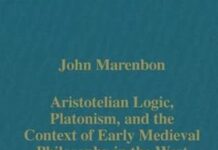
Ebook Info
- Published: 2002
- Number of pages: 214 pages
- Format: PDF
- File Size: 0.62 MB
- Authors: John Marenbon
Description
Compact but singularly well thought out material of a theological, logical, poetic as well as philosophical nature.
User’s Reviews
Reviews from Amazon users which were colected at the time this book was published on the website:
⭐This book is a well-known classic. Author is internationally well-known and explains things inthe most precise way. Covers all necessary ground.
⭐excellent text
⭐In Book I of his Politics, Aristotle writes, “But he who is unable to live in society, or who has no need because he is sufficient for himself, must be either a beast or a god: he is no part of a state.” Something similar is true for intellectual work: when you are educated in a paradigm, there are questions that feel natural and you know that other people also care about these questions, while if you do not have a paradigm your thinking will be scattered. In the Latin Middle Ages, people did not have a paradigm of philosophy and science to work in, and thus their writings seem amateurish and esoteric to us. Until the 11th century, it is more useful to think about the development of a tradition of doing philosophy than about the actual writings as such.This book tells us about the antique writings that were transmitted to the Latin Middle Ages: Chalcidius’s translation and commentary of Plato’s Timaeus (the only of Plato’s writings that were transmitted), Cicero, Seneca, St. Augustine, Martianus Capella’s De nuptiis, Macrobius’s commentary on Cicero’s Dream of Scipio, Porphyry’s Isagoge, Priscian’s Grammar, Boethius’s translations and writings, Pseudo-Dionysius, the Categoriae decem of Pseudo-Augustine, and not many others.Eriugena is not a representative early medieval thinker, and rather than writing books like his Periphyseon, the conventional form of scholarship was writing glosses or at most commentaries on the great works that had been transmitted. This was a worthy project and should not be derided as the work of lesser minds: there was a huge amount of digestion of antique writings that had to be done, especially sorting out how far they could be reconciled with Revelation. The strongest thread that Marenbon follows in this book is Aristotelian logic, which never seems to have been entirely forgotten, although at times was understood and used at a low level.Writing about St. Damian, who is often characterized as a reactionary, Marenbon says: “In the mid-eleventh century, then, especial attention was paid by thinkers to logic in connection with theology. In the late eighth and ninth centuries, a conjunction of these two disciplines had led scholars to ask certain philosophical questions and develop some philosophical ideas. Part of this process had consisted in making logical concepts metaphysical ones, or developing theological implications from them; and the result had sometimes been to confuse logic, metaphysics and theology in a manner superficially exciting, but ultimately meaningless.”Marenbon discusses St. Anselm and Abelard, and also a writer on natural philosophy about whom I hadn’t heard before, William of Conches, who I found remarkable for agreeing with Epicurean atomism which was not a common opinion among scholastic writers.
Keywords
Free Download Early Medieval Philosophy 480-1150: An Introduction 2nd Edition in PDF format
Early Medieval Philosophy 480-1150: An Introduction 2nd Edition PDF Free Download
Download Early Medieval Philosophy 480-1150: An Introduction 2nd Edition 2002 PDF Free
Early Medieval Philosophy 480-1150: An Introduction 2nd Edition 2002 PDF Free Download
Download Early Medieval Philosophy 480-1150: An Introduction 2nd Edition PDF
Free Download Ebook Early Medieval Philosophy 480-1150: An Introduction 2nd Edition





